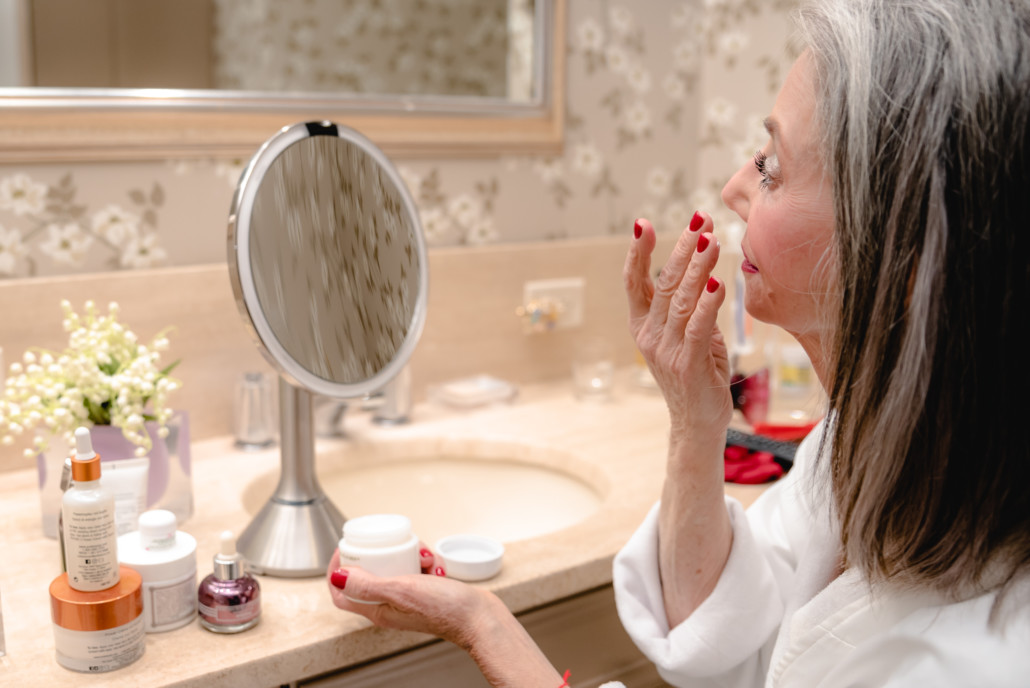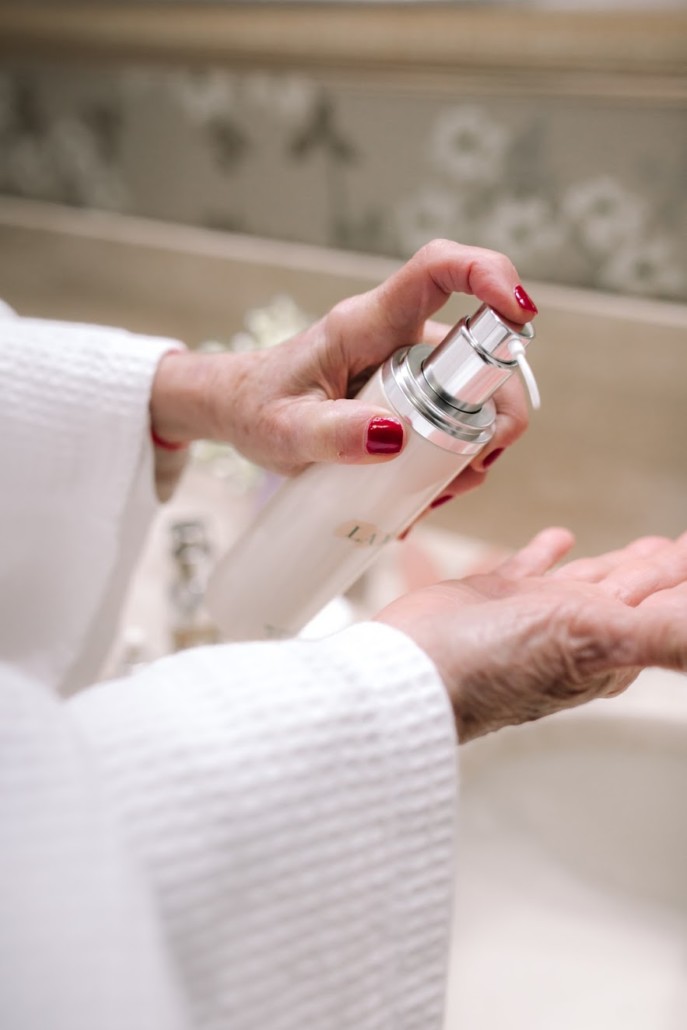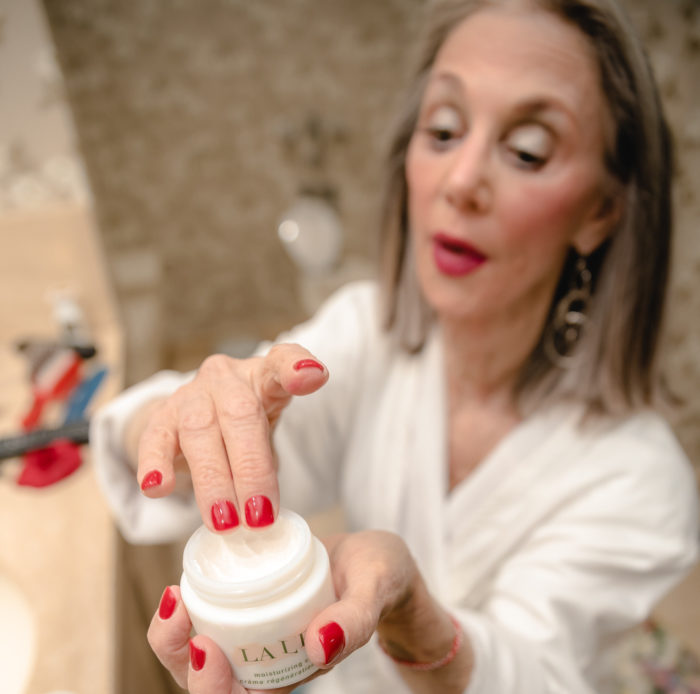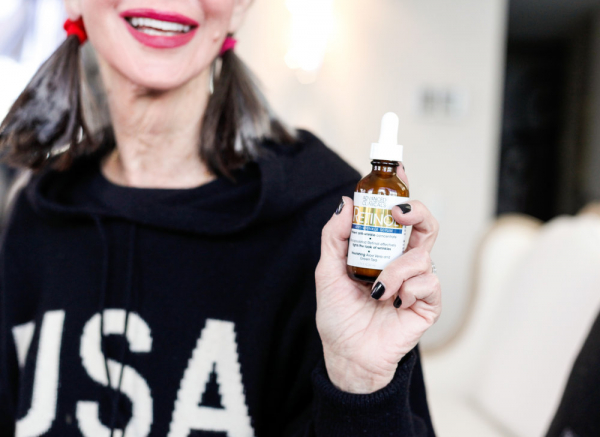Today’s post on menopausal skin and how to care for it was written by Cora Gold, Cora Gold is a skincare and beauty writer, as well as the editor at women’s lifestyle magazine, Revivalist. She knows her stuff when it comes to caring for aging skin. Enjoy, darlings!

Along with changes in your hormones that affect everything from sex drive to changes in your hair, whether you’re premenopausal, menopausal, or postmenopausal, your skin is changing, and you must make changes to how you care for it.
During menopause, your body undergoes many changes. While you go through menopause, you may be aware of the common symptoms, such as hot flashes, but there are some that you may not expect. As your hormones begin to change, you may experience changes in your skin. These hormonal shifts happen both before and after your last period, and understanding this transition is important for managing your skin health.
You should love the skin you’re in, no matter your age. While wrinkles and fine lines are perfectly natural, it’s normal to struggle with your self-image as you age. You shouldn’t feel pressured to seek procedures to keep up with beauty standards, though. Your skin is your body’s largest organ, so you should care for it like any other part of your body.
Just like how your skin changed when you went through puberty, you may have a similar experience during menopause. You shouldn’t feel ashamed of these changes, but there are ways you can take special care. Here’s how to care for your menopausal skin so you look and feel great during this transition.
What Is Menopausal Skin and Skin Changes?

Menopause brings many changes and doesn’t discriminate regarding your skin. Menopause skin is especially affected by hormonal fluctuations. During premenopause, your skin could become inflamed due to hot flashes. You could experience a rash with hives or red bumps if you have sensitive skin. Additionally, you could get acne from hormonal changes or experience slight sagging. Hormonal fluctuations during menopause can also lead to adult acne, as changes in sebum production may cause breakouts in adult women.
Your testosterone, estrogen, and progesterone levels drop drastically during menopause. Your body also stops making as much collagen, which supports your skin’s elasticity.
Not only that, but your skin will lose about 30% of its collagen during the first five years of menopause, causing a loss of firmness. Collagen loss can also increase the appearance of pores. Testosterone reduces sebaceous gland activity, which can lead to less sebum production and potentially less acne. However, both increased and decreased sebum production can affect menopause skin—too much sebum can clog pores and cause adult acne, while too little can make your skin more dry and prone to wrinkles. Be prepared for thinning, sagging, slack skin, and wrinkling as you navigate menopause.
In summary, you may experience these changes to your skin during menopause:
- Inflammation
- Rashes, hives, or redness
- Acne (including adult acne)
- Loss of firmness and elasticity (slack skin)
- Enlarged pores
- Wrinkles and dryness
As skin ages, it undergoes gradual changes such as decreased collagen and elastin, leading to slack skin and other visible signs of aging. This list might sound scary, but it’s all a natural part of aging. If your skin becomes irritated or sensitive during menopause, there are plenty of natural ways you can care for it. Here are some steps you can take to alleviate menopausal skin symptoms.
Understanding Skin Changes During Menopause
Menopause is a natural milestone in every woman’s life, usually occurring between the ages of 45 and 55, and it brings with it a host of changes—not just to your menstrual cycle, but to your skin as well. As estrogen levels drop, you may notice your skin becoming drier, thinner, and less elastic. This is because estrogen plays a key role in collagen production, which helps keep skin firm and youthful. When collagen levels decrease, the skin loses its plumpness, leading to sagging skin, new wrinkles, and even age spots.
Another common change is the skin’s reduced ability to retain moisture, making dry skin and irritation more likely. You might also see an increase in unwanted facial hair due to shifting hormone levels. For some, laser hair removal can be an effective way to manage these changes and boost confidence.
To help your skin adapt, consider switching to a fragrance-free moisturizer that’s gentle on sensitive skin and helps lock in hydration. Don’t forget to apply a broad spectrum sunscreen every day, as aging skin is more vulnerable to sun damage and age spots. By understanding these skin changes and making a few adjustments to your skincare routine, you can help your skin stay healthy, comfortable, and radiant throughout menopause.
Common Skin Disorders and Conditions in Menopause
As hormone levels fluctuate during menopause, many women experience new or worsening skin conditions. Menopausal acne is a frequent concern, even for those who haven’t had breakouts since their teenage years. Ingredients like salicylic acid and benzoyl peroxide can help treat acne and keep pores clear, but it’s important to choose products that won’t overly dry or irritate your skin.
Dry skin is another common complaint, as the skin’s ability to retain moisture diminishes. Hyaluronic acid-based moisturizers are excellent for boosting hydration and helping your skin stay supple. Sensitive skin can also become more of an issue, so opt for gentle, fragrance-free products to minimize irritation.
With age, the risk of skin cancer increases, making regular skin self exams and visits to a dermatologist more important than ever. Hormonal changes can also lead to increased facial hair, which many women find bothersome. Laser hair removal or topical therapy can be effective solutions for unwanted facial hair.
By understanding these common skin disorders and taking proactive steps—like using the right products, treating dry skin, and scheduling regular check-ups—you can reduce visible wrinkles, age spots, and irritation, and keep your skin looking its best during menopause.
How to Care for Menopausal Skin

The most important way to care for menopausal skin is to use the right products and ingredients. Your skin will likely become much more dry, so moisturizing will be essential.
Use night creams instead of daytime moisturizers to lock in moisture, and avoid cleansers with alpha hydroxy acid since it can dry out your skin. Look for ingredients like salicylic acid that can penetrate your pores and dissolve oil. Additionally, you’ll want to use a moisturizer with antioxidants like vitamins C and E to repair your skin. Ceramides are also useful ingredients in moisturizers since they keep moisture from escaping.1 It is also important to use products that help treat dry skin, especially during menopause.
Wearing sunscreen daily can help you prevent wrinkles and reduce existing ones. While wrinkles are a natural part of life, excessive sun exposure can cause bigger problems, such as skin cancer. You should apply it even when it’s cloudy outside, as the sun’s rays will still penetrate your skin. For optimal sun protection, use a broad-spectrum sunscreen with SPF 30 or higher and reapply during prolonged sun exposure or after swimming. Add a layer of vitamin C before your sunscreen to help combat discoloration, reduce the appearance of brown spots and prevent new ones.
You should reassess your skin as your skin’s pH level changes to determine your best skincare routine. Try various products or visit a dermatologist to create an efficient treatment plan. Dermatologists can provide expert diagnosis and personalized treatment plans for menopausal skin, and may recommend advanced procedures if needed. Avoid irritating ingredients in skin care products and detergents until you’re familiar with your newly sensitive skin.
Tips for Postmenopausal Skin

Once you’ve determined an effective skincare routine and understand how your skin changes during menopause, understand that your skin and hair will likely change a little more. Postmenopausal women experience a drastic drop in progesterone and estrogen levels after menopause—so much that they’re sometimes undetectable. Oestrogen deficiency after menopause can contribute to symptoms like dry skin, slack skin, and flushing. Therefore, you should continue using skin care products like retinol, peptides, and antioxidants. Oestrogen therapy may be considered as a treatment option for skin symptoms such as flushing, dryness, and dermatitis in postmenopausal women. Topical oestrogen can also help improve skin barrier function and increase collagen and elastin in postmenopausal women.
Your skin quits producing hyaluronic acid—which helps boost collagen and seals in moisture—after menopause. A serum with hyaluronic acid can mimic these useful functions and help combat dry skin. Prevention is crucial to keeping your skin healthy, so monitor and maintain your skin’s changes during perimenopause and menopause to prepare you for post-menopausal skin care. The genital region is particularly sensitive to hormonal changes due to a high density of oestrogen receptors, making it more susceptible to symptoms like dryness and irritation. Vaginal dryness is also a common symptom in postmenopausal women, related to decreased estrogen levels. Acquired bilateral melanosis is another skin condition that can occur in perimenopausal and postmenopausal women, especially in certain populations.
You may not be able to prevent your skin changes, but you can take actionable steps to prevent irritation and weakened skin. Staying hydrated and eating a balanced diet can improve your skin from the inside out. Eat foods rich in water, like watermelon, strawberries, skim milk, broths, and soups, to help you stay hydrated and nourish your skin.
Drink plenty of water throughout the day, and carry a refillable bottle and replenish it when it gets low. You can infuse it with fruit or cucumbers to add a hint of flavor if you find plain water too bland.
Hormone Replacement Therapy and Your Skin
Hormone Replacement Therapy (HRT) is a treatment option that some women consider to help manage menopausal symptoms, including those that affect the skin. By supplementing declining hormone levels, HRT can help improve skin hydration, boost collagen production, and reduce the appearance of wrinkles and sagging. This can make a noticeable difference in skin barrier function and overall skin health.
However, HRT isn’t without risks. It’s important to be aware of potential side effects, such as an increased risk of venous thromboembolism and endometrial cancer. For women who want to avoid these risks, topical estrogen therapy—applied directly to the skin—can offer targeted benefits, such as improved skin barrier and reduced dryness, without the systemic effects of oral HRT.
If you’re struggling with menopausal acne, HRT may also help balance hormone levels and treat acne-prone skin. As always, it’s essential to consult with a dermatologist or healthcare provider to discuss your unique skin condition and determine the best treatment options for you. With the right approach, you can address skin changes during menopause and maintain healthy, vibrant skin.
Caring for Your Skin During Menopause and Beyond
Your skin naturally undergoes many changes as you age — it comes with the territory. If you want to embrace aging gracefully, there’s no need to fight against it through procedures or heavy makeup. Instead, nurture your skin through a healthy lifestyle and the right skincare techniques. The most important thing is to love yourself and your skin as you age gracefully.
Sources:
- https://www.rejuvenationclinicofsaukprairie.com/blog/skin-rejuvenation-101/
 Author bio: Cora Gold is a skincare and beauty writer, as well as the editor at women’s lifestyle magazine, Revivalist. Connect with Cora on LinkedIn, Twitter, and Pinterest.
Author bio: Cora Gold is a skincare and beauty writer, as well as the editor at women’s lifestyle magazine, Revivalist. Connect with Cora on LinkedIn, Twitter, and Pinterest.
Have you found any special tips or tricks to care for your menopausal or post-menopausal skin? I’d love for you to share in the comments.
If you enjoyed this story, please subscribe to my email list. When I post a new story, you will receive it in your inbox.

+ show Comments
- Hide Comments
add a comment